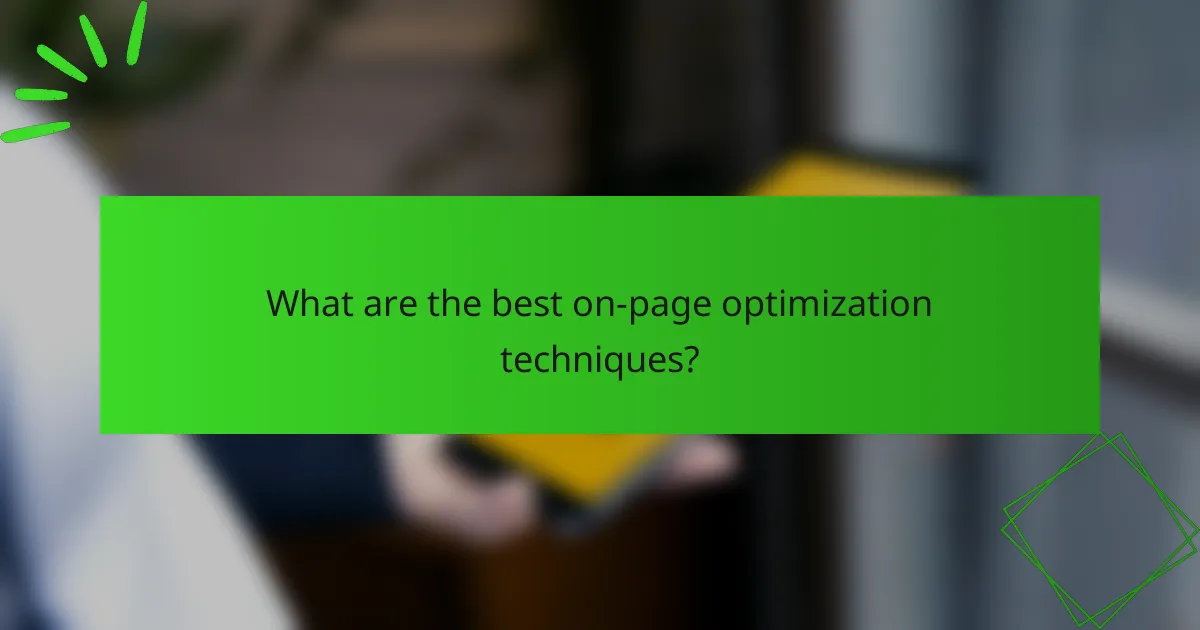In today’s competitive digital landscape, effective SEO strategies are crucial for enhancing visibility and driving targeted traffic to websites. By focusing on keyword optimization, user experience, and local tactics, businesses can significantly improve their online presence. Implementing best practices in on-page optimization further ensures that content resonates with both search engines and users, ultimately leading to increased conversions.

What are effective SEO strategies for digital products in Canada?
Effective SEO strategies for digital products in Canada focus on optimizing keywords, enhancing user experience, and implementing local tactics. By combining these elements, businesses can improve visibility and drive targeted traffic to their websites.
Keyword research tools like Ahrefs
Keyword research tools such as Ahrefs are essential for identifying relevant search terms that potential customers use. These tools provide insights into search volume, keyword difficulty, and competitive analysis, helping you choose the right keywords for your digital products.
Utilize Ahrefs to explore long-tail keywords that may have lower competition but higher conversion potential. Regularly updating your keyword strategy based on trends can significantly enhance your SEO efforts.
On-page optimization techniques
On-page optimization involves refining individual web pages to rank higher and earn more relevant traffic. Key techniques include optimizing title tags, meta descriptions, header tags, and ensuring keyword placement within the content.
Additionally, focus on improving page load speed and mobile responsiveness, as these factors are crucial for user engagement and search rankings. Tools like Google PageSpeed Insights can help identify areas for improvement.
User experience enhancements
Enhancing user experience (UX) is vital for retaining visitors and encouraging conversions. A well-structured website with intuitive navigation, clear calls-to-action, and engaging visuals can significantly improve user satisfaction.
Consider conducting user testing to gather feedback on your website’s design and functionality. Ensuring that your site is accessible and provides valuable content will also contribute positively to the overall user experience.
Content marketing approaches
Content marketing is a powerful strategy for driving organic traffic and establishing authority in your niche. Create high-quality, informative content that addresses the needs and interests of your target audience.
Incorporate various formats such as blog posts, videos, infographics, and podcasts to engage users effectively. Regularly updating your content can help maintain relevance and improve your site’s SEO performance.
Local SEO tactics
Local SEO tactics are crucial for businesses targeting Canadian customers. Start by claiming and optimizing your Google My Business listing, ensuring that your business information is accurate and up-to-date.
Incorporate local keywords into your content and meta tags, and encourage customer reviews to enhance your local search visibility. Participating in local events and building relationships with other businesses can also boost your local presence.

How to conduct keyword research for digital products?
Keyword research for digital products involves identifying terms and phrases that potential customers use to search for those products. This process helps optimize content and improve visibility in search engines, ultimately driving traffic and conversions.
Using Google Keyword Planner
Google Keyword Planner is a free tool that helps you discover keywords related to your digital products. Start by entering a few relevant terms or your website URL to generate keyword ideas along with metrics like search volume and competition level.
Focus on keywords with a balance of high search volume and manageable competition. Aim for keywords that align closely with your product offerings to attract the right audience.
Analyzing competitor keywords
Examining the keywords your competitors rank for can provide valuable insights. Use tools like SEMrush or Ahrefs to identify which keywords drive traffic to their sites.
Look for gaps in their keyword strategy where you can compete effectively. This can reveal opportunities to target less competitive keywords that still attract relevant traffic.
Identifying long-tail keywords
Long-tail keywords are longer, more specific phrases that typically have lower search volume but higher conversion rates. These keywords often indicate a more defined search intent, making them valuable for targeting niche markets.
To find long-tail keywords, consider using phrases that include product types, features, or specific use cases. For example, instead of just “digital camera,” use “best digital camera for wildlife photography.” This approach can help you reach users who are further along in the buying process.

What are the best on-page optimization techniques?
The best on-page optimization techniques focus on enhancing individual web pages to improve search engine rankings and user experience. Key strategies include optimizing title tags, using header tags effectively, and implementing image optimization practices.
Optimizing title tags and meta descriptions
Title tags and meta descriptions are critical for on-page SEO as they influence click-through rates from search results. A well-crafted title tag should be around 50-60 characters, including primary keywords, while meta descriptions should be concise, ideally between 150-160 characters, summarizing the page content.
To optimize these elements, ensure they are unique for each page and relevant to the content. Avoid keyword stuffing; instead, focus on creating compelling text that encourages users to click through to your site.
Using header tags effectively
Header tags (H1, H2, H3, etc.) structure your content and help search engines understand the hierarchy of information. The H1 tag should contain the main keyword and clearly describe the page’s topic, while H2 and H3 tags can be used for subheadings that break down content into manageable sections.
Use header tags to enhance readability and guide users through your content. Ensure each header is descriptive and relevant, as this not only aids SEO but also improves user engagement.
Image optimization practices
Image optimization is essential for improving page load speed and enhancing user experience. Use appropriate file formats, such as JPEG for photographs and PNG for graphics, and compress images to reduce file size without sacrificing quality.
Additionally, include descriptive alt text for each image, which helps search engines understand the content and improves accessibility. Aim for alt text that is clear and includes relevant keywords, but avoid over-optimization.

How does user experience impact SEO?
User experience (UX) significantly affects SEO by influencing how visitors interact with a website. A positive UX can lead to lower bounce rates and higher engagement, which search engines interpret as a sign of quality, potentially boosting rankings.
Importance of site speed
Site speed is a critical factor in user experience and SEO. Websites that load quickly tend to retain visitors, while slow-loading sites can frustrate users and lead to higher abandonment rates. Aim for a loading time of under three seconds to optimize both UX and search engine rankings.
To improve site speed, consider optimizing images, leveraging browser caching, and minimizing JavaScript. Tools like Google PageSpeed Insights can provide actionable recommendations for enhancements.
Mobile responsiveness factors
Mobile responsiveness is essential as an increasing number of users access websites via mobile devices. A responsive design ensures that your site adapts to various screen sizes, providing a seamless experience regardless of the device. Google prioritizes mobile-friendly sites in its search results.
To enhance mobile responsiveness, use flexible grids and layouts, optimize touch elements for easy navigation, and ensure that text is readable without zooming. Regularly test your site on multiple devices to identify and fix any issues.
Navigation and layout best practices
Effective navigation and layout are crucial for a positive user experience, which in turn supports SEO. Clear menus, logical structure, and easy-to-find information help users find what they need quickly, reducing frustration and encouraging longer visits.
Implement best practices such as using descriptive labels for navigation links, ensuring a consistent layout across pages, and including a search function. Avoid cluttered designs and prioritize essential content to guide users naturally through your site.

What are the key metrics to measure SEO success?
Key metrics to measure SEO success include organic traffic growth, conversion rates, and bounce rates. These metrics provide insights into how well your website is performing in search engines and how effectively it engages visitors.
Organic traffic growth
Organic traffic growth refers to the increase in visitors coming to your website from search engine results without paid advertising. Monitoring this metric helps you understand the effectiveness of your SEO strategies over time.
To measure organic traffic growth, use tools like Google Analytics to track the number of visitors from search engines. A healthy growth rate typically ranges from 10% to 30% annually, depending on your industry and competition.
Focus on optimizing your content and keywords to enhance visibility. Regularly updating your site with fresh, relevant content can significantly boost organic traffic.
Conversion rates
Conversion rates indicate the percentage of visitors who complete a desired action, such as making a purchase or signing up for a newsletter. High conversion rates suggest that your site effectively meets user needs.
To calculate conversion rates, divide the number of conversions by the total number of visitors, then multiply by 100. A good conversion rate typically falls between 2% and 5%, but this can vary widely by industry.
Improving conversion rates can involve optimizing landing pages, simplifying the checkout process, and ensuring clear calls to action. A/B testing different elements can help identify what resonates best with your audience.
Bounce rates
Bounce rates measure the percentage of visitors who leave your site after viewing only one page. A high bounce rate may indicate that your content is not engaging or relevant to users.
To calculate bounce rates, divide the number of single-page visits by the total number of entries to your site, then multiply by 100. Generally, a bounce rate below 40% is considered good, while rates above 70% may need attention.
To reduce bounce rates, improve page load speeds, enhance content quality, and ensure that your site is mobile-friendly. Engaging visuals and clear navigation can also keep visitors on your site longer.

What are the prerequisites for implementing SEO strategies?
To effectively implement SEO strategies, a solid understanding of keywords, optimization techniques, and user experience is essential. These prerequisites ensure that your website is not only visible to search engines but also provides a positive experience for users.
Understanding Keywords
Keywords are the terms and phrases that users enter into search engines. Identifying relevant keywords for your content is crucial, as it helps align your website with user intent. Use tools like Google Keyword Planner or SEMrush to discover high-volume keywords that resonate with your target audience.
When selecting keywords, consider their search volume and competition level. Aim for a mix of short-tail keywords, which are broader and more competitive, and long-tail keywords, which are more specific and often less competitive. This approach can enhance your chances of ranking higher in search results.
On-Page Optimization Techniques
On-page optimization involves adjusting elements on your website to improve its visibility in search engines. Key factors include optimizing title tags, meta descriptions, header tags, and image alt texts. Ensure that your primary keywords are included naturally in these elements to signal relevance to search engines.
Additionally, focus on creating high-quality, engaging content that addresses user needs. Use internal linking to guide users to related content on your site, which can improve dwell time and reduce bounce rates. Regularly updating your content can also signal freshness to search engines.
User Experience Considerations
User experience (UX) is a critical component of SEO that affects how visitors interact with your site. A well-designed website that loads quickly, is mobile-friendly, and has intuitive navigation can significantly enhance user satisfaction. Aim for load times under three seconds to minimize user frustration.
Incorporate clear calls to action and ensure that your site is accessible to all users, including those with disabilities. Regularly testing your website’s usability can help identify areas for improvement, ultimately leading to better engagement and higher search rankings.










